This is an extract from the Carloviana published in 2019 all about the village of the Royal Oak, where our pub is. It was sitting in my house for ages, so I'd said be great to share it.

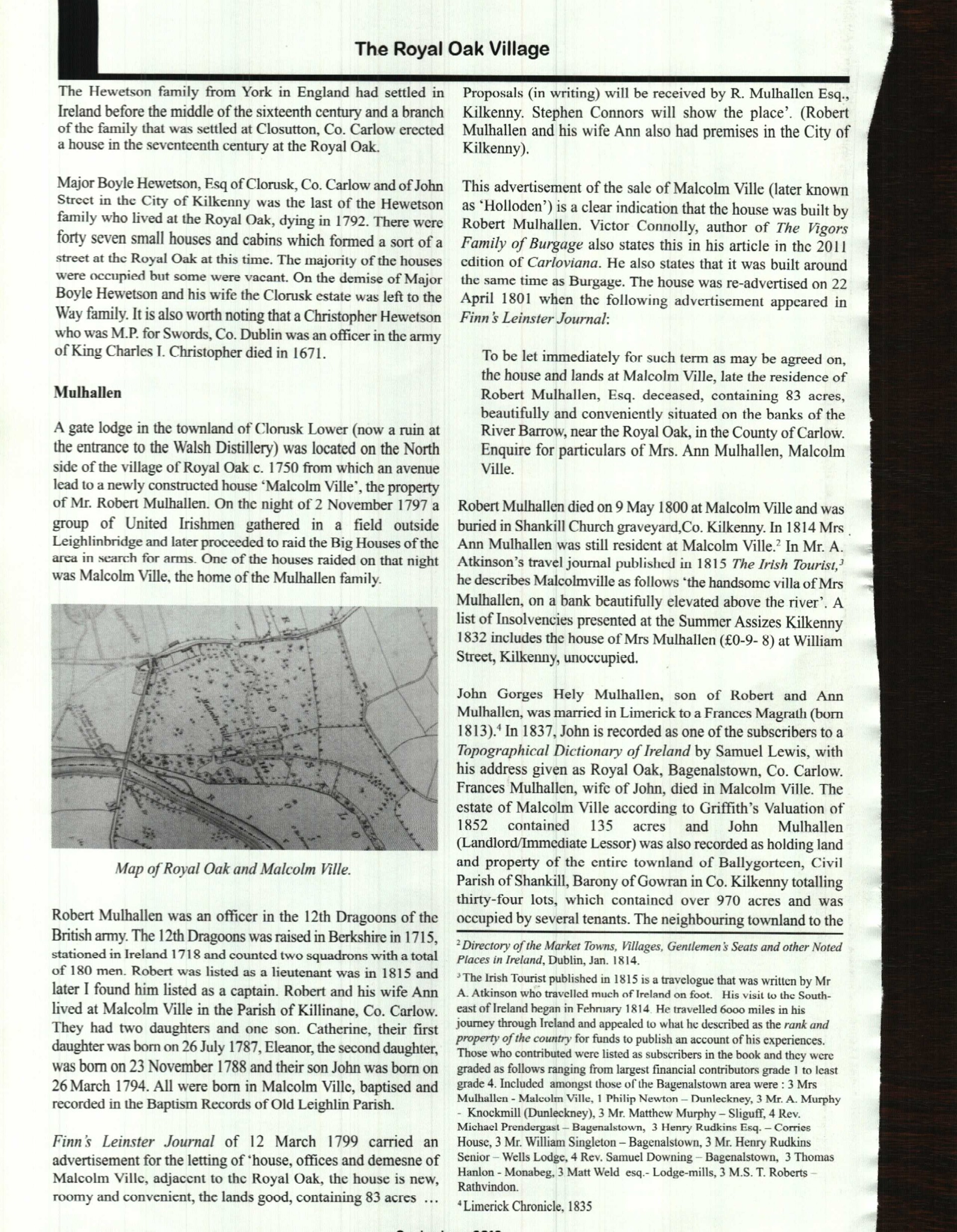


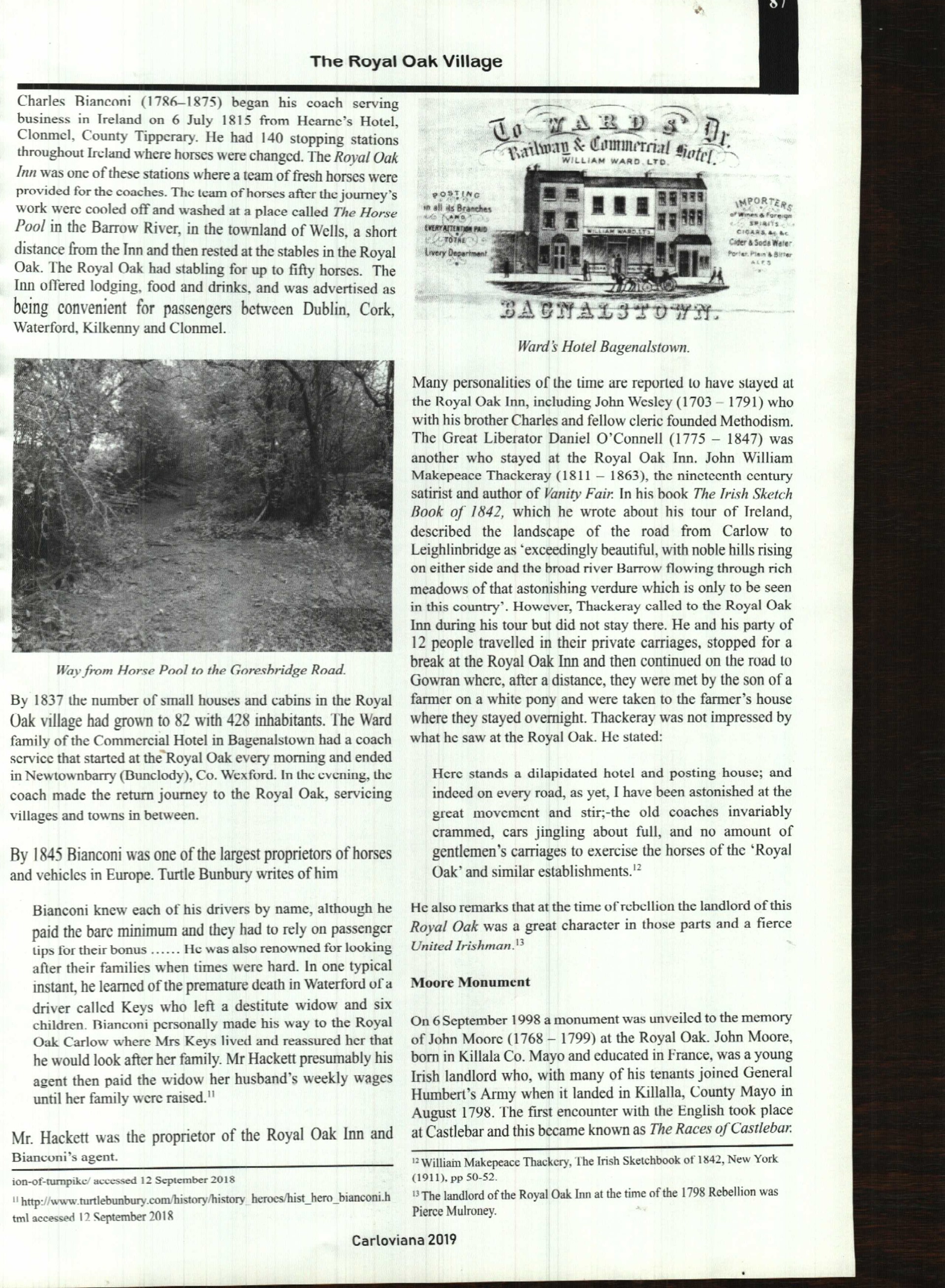
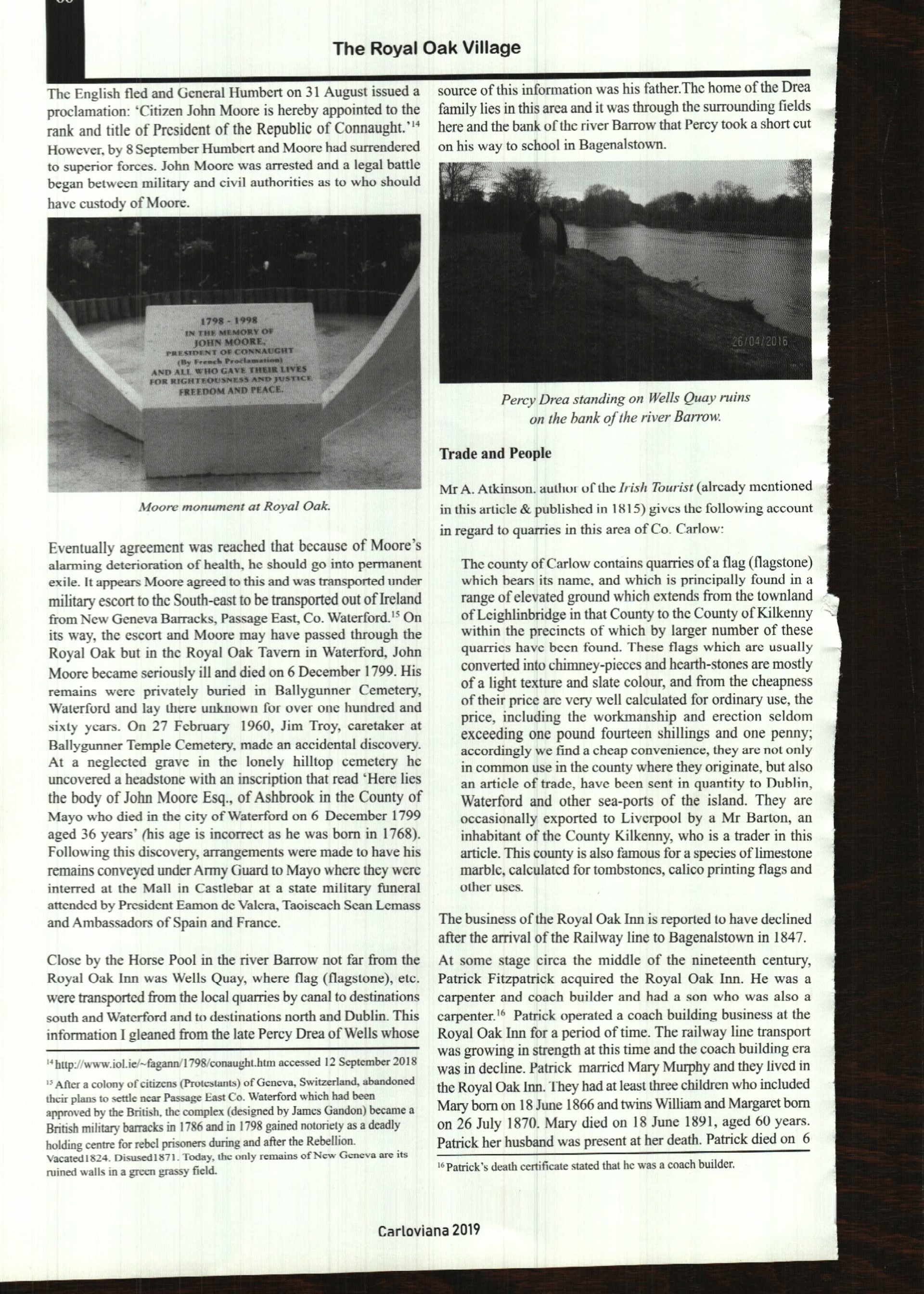
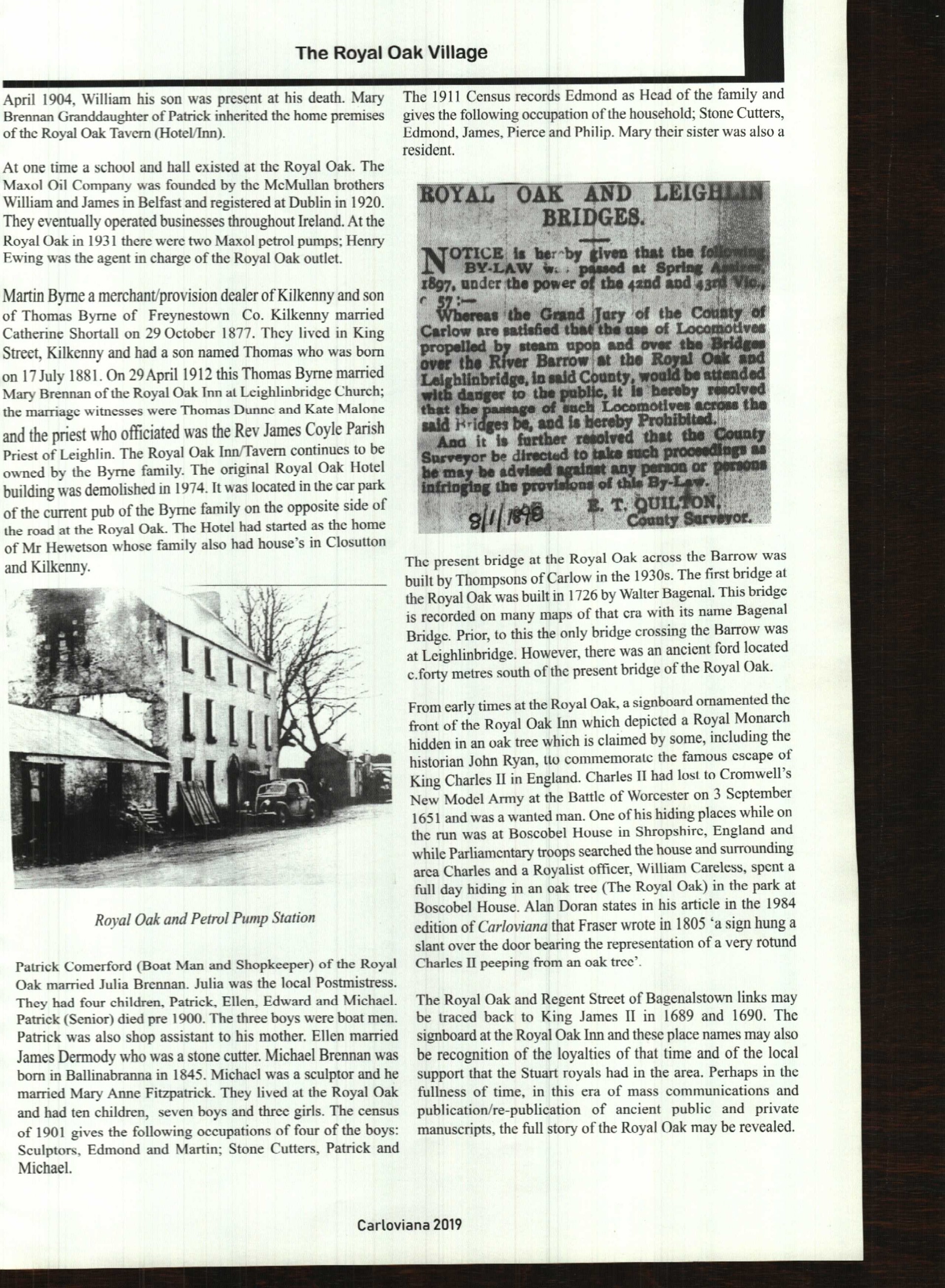


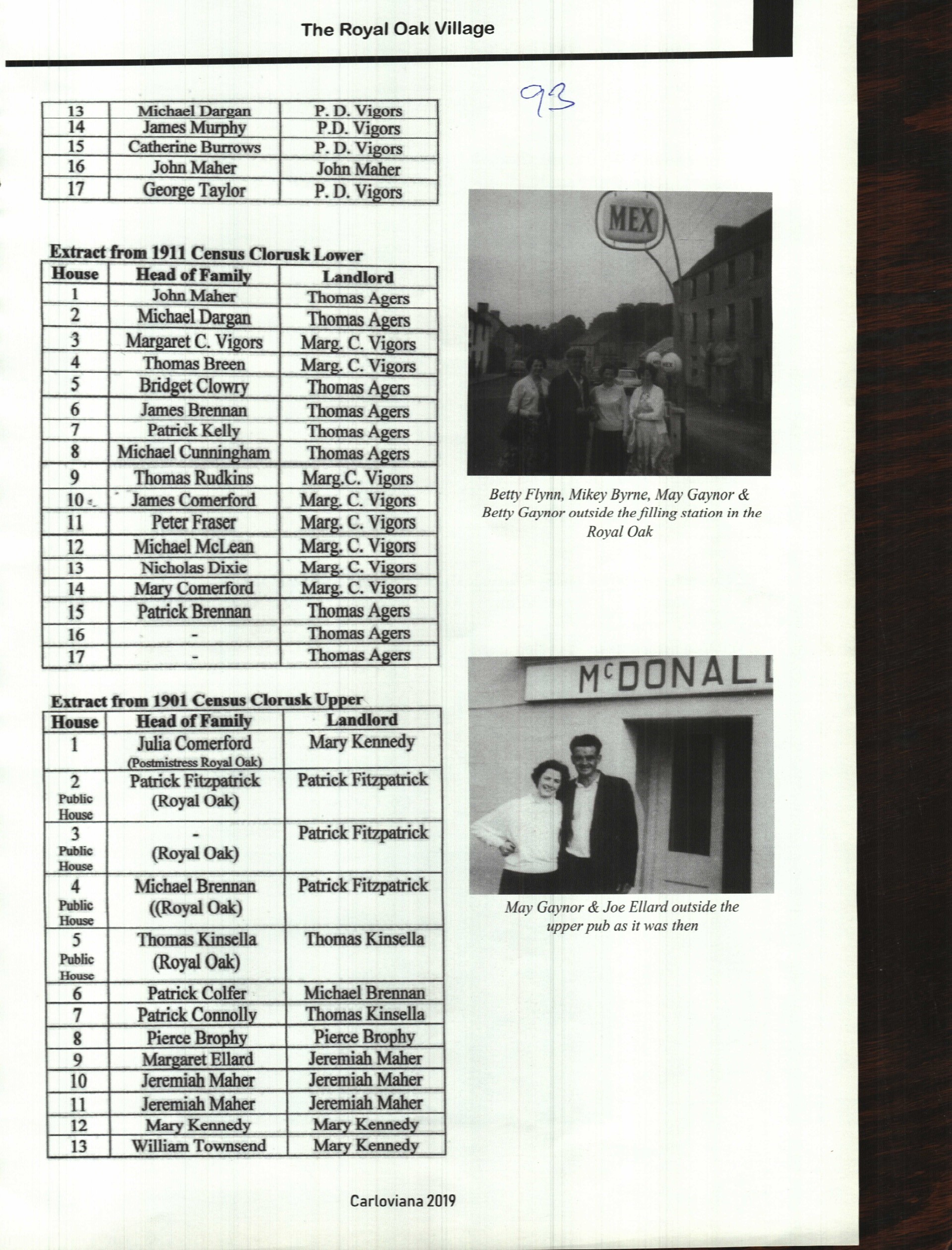
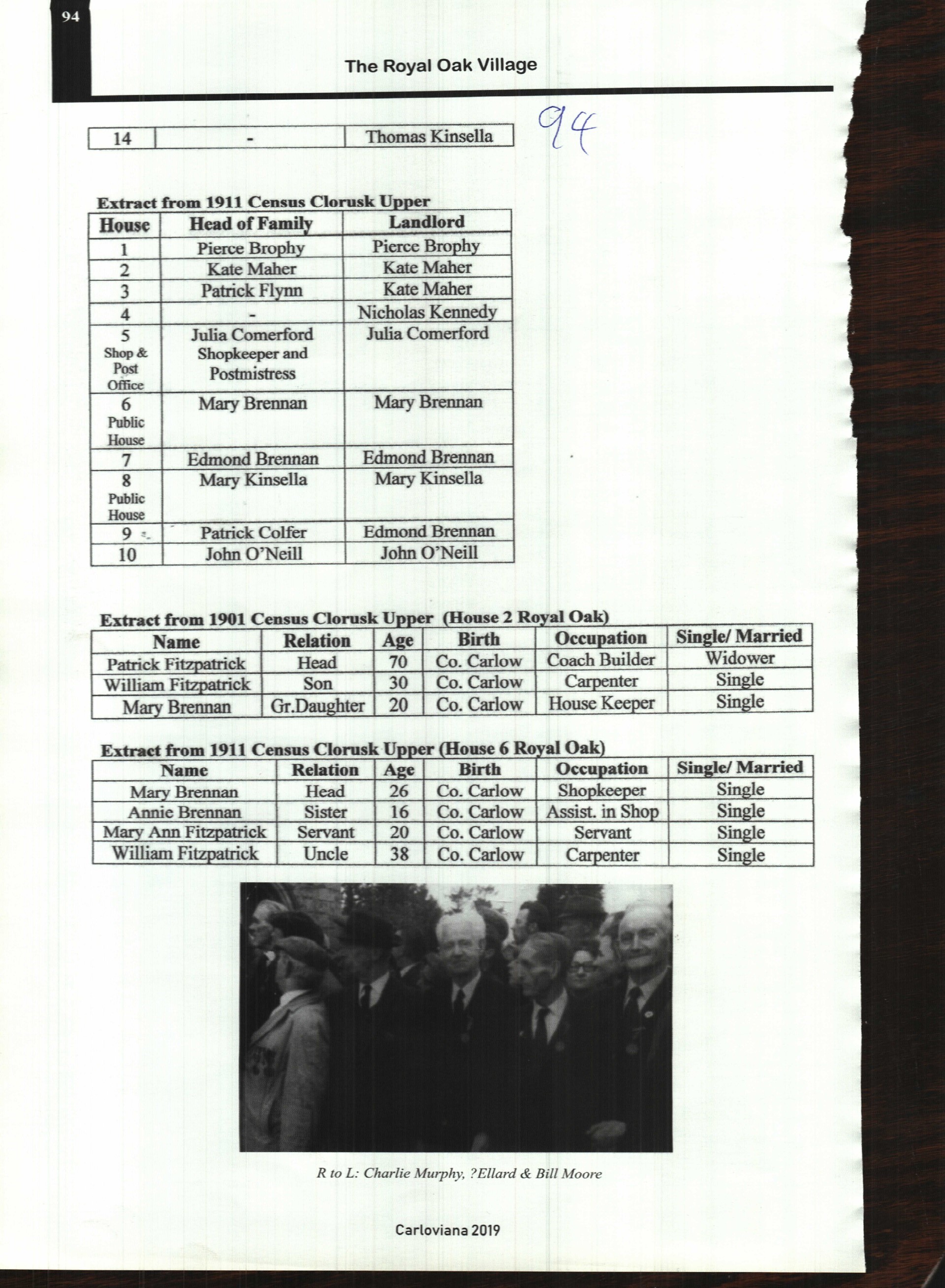
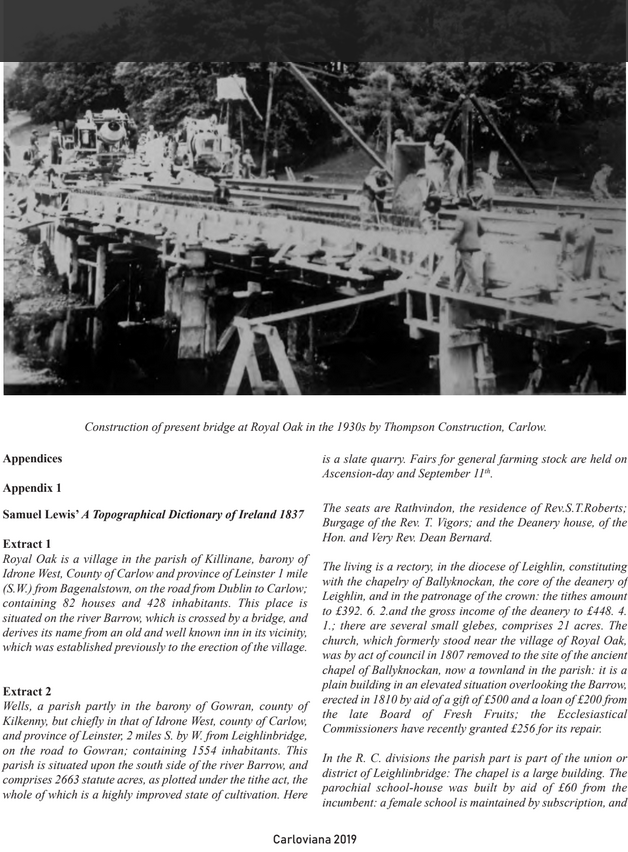


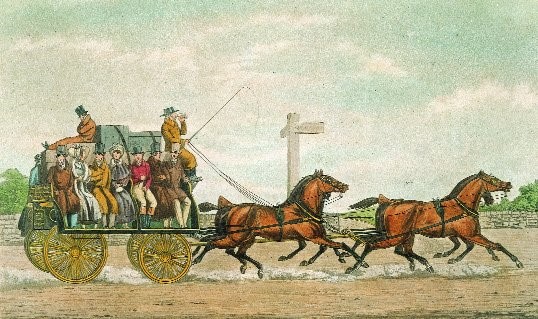
Source: https://www.historyireland.com/18th-19th-century-history/irelands-time-space-revolution-improvements-to-pre-famine-travel/
ON the Dublin road north of Leighlinbridge and over one mile distant from the village, there is a bridge crossing the stream, which flows between the townslands of Orchard and Powerstown at this point, it is known as Orchard bridge.
Great improvements have been made on the road here and the marks of the earth works remain which show us that there was a very steep hill down to the bridge.
Back in the 1760's there was no bridge here; the road just ran through a broad, shallow hard bottomed stream. Coach or cart splashed through, and if going south towards Kilkenny the weary horses had to face a very steep climb up from the river and then on through Leighlin.
The wayfarer could cross the river and keep a dry foot by an arrangement of granite stones which were spaced out across the river bed. The stones were circular about 22" in diameter, chiselled flat on top and stood about eight or nine inches above the normal water level. The stones were probably put there by the people who owned Orchard Mills. They were known as "The Stepping Stones of Orchard".
There was a road junction here and one could avoid the hill, bear east through the village of Orchard and go on through Ballinaboley, Rathellen, Rathduff, Dunleckney and cross Bagenals Bridge to the Royal Oak.
The little road (part of which is still open) was the route which Bagenal hoped to see developed into the main coach road. The mail coach would pass by his main gate and through his town. Thus Leighlinbridge would have been by-passed about 200 years before its time.
There was a family who possessed Hotels at Leighlinbridge and The Royal Oak who had other ideas. They were led by the young proprietor of The Royal Oak Inn who was a wild and very popular character "named Cornelius Hackett.
- "The Devil himself an Inn bespoke
- And he placed it in The Royal Oak
- When he wanted someone to back it
- What better man, than blind Con. Hackett".
Hackett's face was marked by a sword cut which disfigured his right eye; such marks were worn with great pride by young men in those days. This stanza was rhymed about him in his latter days.
The Hotel was three storied, Georgian and bearing the name 'Royal Oak1. Fraser wrote in 1805 "a sign hung aslant over the door bearing the representation of a very rotund Charles II peeping from an Oak tree.
Ryan the historian wrote:—
"This well known Inn was established here, probably a century ago; and if we judge from the signboard that ornaments the front of the house, is named in commemoration of the famous escape of King Charles II by concealment in an Oak tree."
Bagenal tried to get the coach road to pass by his main gate at Dunleckney and through his new and handsome town. But while they were the most powerful family in Carlow, Bagenal was not favoured in Parliament at that time. When the Act came up to improve the Dublin-Kilkenny road the Hacketts lobbied successfully, they had access to some of the M.P.'s from the South, as they stayed overnight at the Royal Oak or Leighlinbridge.
In 1768 the bridge of Leighlin was widened by 8 feet and the hill at Orchard was lowered to some degree. The turnpikes at Powers-town (just up from the bridge of Orchard) and at Ballyknockan seem to have been erected at the same time. There is no trace to be found of the Pike of Powerstown and the house known as Ryans of the Tike' is gone long ago. The base of the Pike at Burgage is still there.
Ryan the Historian mentions a stone at Burgage which was he said, one of the marking stones of the Burrough of Old Leighlin. Other historians referred to Ryan and so this minor local mistake is perpetuated; perhaps Ryan may have been describing a different stone. The antiquary will find but one stone now, a holed plinth recessed in the wall, with 18 feet clearance on each side to permit the pike to yield to the traffic from either direction. We have no documented proof on this stone which bears the appellation "The Wart Stone"; because due to the danger and difficulty of collecting tolls at country turnpikes the whole business of tolls was removed to the Tholsel in Kilkenny in the year 1780. If Ryan had enquired from the locals he could perhaps have spoken to people with memory of the turnpikes.
 The 'Royal Oak' was important because the horses were changed there at every call and no change would be normally made nearer than Kilkenny and Carlow.
The 'Royal Oak' was important because the horses were changed there at every call and no change would be normally made nearer than Kilkenny and Carlow.
The Cork mail coach with a double guard set out from Camden St., Dublin at 7.45 p.m. through Naas, Kilcullen, Castledermot, Carlow, Leighlin, Royal Oak - Clonmel, and arrived at Cork at 9.30 p.m. the following night, doing that distance in 25¾ hrs. The coach from Cork sets out at midday and passed through the County Carlow at the dead of night or small hours of the morning.
The day stage coaches were from Dublin to Kilkenny and Kilkenny to Dublin leaving 7 o'c. a.m. and 6 o'c. a.m. The traveller from Dublin could expect to be in time for dinner at Kilkenny. If the coach ran late they could dine at Carlow, Leighlinbridge, or Royal Oak. The whole approach to the stage coach was very casual, when compared to the incredible Dublin-Cork journey by mail coach. They say "that the horses were changed, but the driver was not changed".
Travelling in summer weather was not too bad while the dry roads held firm and the night was light and short. But what a terrible journey this must have been in winter as the coach pressed on without a thought of the suffering of men or beast; through the dreadful roads of those days. Through the real darkness which came with night, the coach sped through the unlighted villages and the dark and dangerous highway; the driver peering into the darkness beyond the halo of candle-lit lamps. The guard beside him nodding in torpor over his loaded blunderbuss.
| Estimated journey times, mid-eighteenth to mid-nineteenth century. | |||
| Mid-18th century | 1820 | 1855/60 | |
| Dublin to Belfast | 3 days in winter | 14 hours | 5hrs 5mins |
| 2 days in summer | |||
| (1742) | |||
| Dublin to Enniskillen | 3 days in winter | 18 hrs 20 mins | 12hrs 30mins |
| 2 days in summer | (Mail Coach) | ||
| (1768) | |||
| Dublin to Mullingar | 1 day | 8hrs | 2hrs |
| Dublin to Kilkenny | Day and a half | c. 11 hours | 3hrs 20mins |
| (1757, 1760) | |||
| Doublin to Cork | 2 days (1793) | 25 hours6hrs 50mins | |
| via Fermoy | |||
| Dublin to Limerick | Advt. 1752-57 no detail on travel time perhaps 3 days | 19hrs 15mins | 5hrs 10mins |
| Source: Contemporary dirfctories, newspapers | |||
| Source: https://www.historyireland.com/18th-19th-century-history/irelands-time-space-revolution-improvements-to-pre-famine-travel/ | |||
Highwaymen and ghosts
There is a point on the Dublin road near Kilcullen where the road bends on a hill and has a wooded embankment on the east side. This spot was a favoured spot for 'Hold Ups' and is known as the Highwaymans turn to the present day.
Again at Maudlin just a ¼| mile south of Leighlinbridge, the coach was often 'Held up' as it was forced to slow down while crossing the river. This was said to be done by the notorious highway man "Freaney the Robber" who having robbed everyone aboard, made away up a lane to the west into the townland to which he gave his name; Fear na Freaney (The place or fields of Freaney). From this place he could ride in so many directions that pursuit was impossible.
The Hackett family of the Royal Oak prospered during the life of Cornelius Hackett (who died 1821) despite the rise of the thriving town of Bagenalstown just ¼ mile away. The decline started during the 1830's. William Hackett son of Cornelius Hackett was then the proprietor. He was a furious O'Connellite and was named as ringleader of a group of people who brought politics to the streets of Carlow, Leighlinbridge and Bagenalstown. He was wounded in an affray in Leighlinbridge during a midnight demonstration against Henry Bruen M.P. He lost the Post horses in the late 1830's but battled on hiring out his stables to Purcell's Day coaches of Kilkenny.
But the day of the post horses was closing. The great Southern and Eastern Railway was soon to end the era of the post horse.
William Hackett died 1841 he was predeceased by his older daughter and only son. His younger daughter married a merchant named Hoey of Old Leighlin (now Matt Lynch's Shop).
Hackett Inn at Leighlinbridge (now Higgins' Shop) made a brief and lurid appearance in history in 1798 when it was taken over by the Yeomen and Militia. It was in the great room, over the wine shop that the trials ran for days during the month of June in that year. Here Paul Cullen of Craan and his cousins Garrett Kinsella of Rathornan, Denis Carey, Old Leighlin, Lacey, Lannin, Carroll and many others unknown were tried. They were all executed in a lane known as "Murdering Lane" which bounded the Hotel premises on the east. Their bodies were dragged down to the Inn yard which was open to the street, as it is to the present day. There they were identified by those who dared to come and claim them. The unclaimed dead were buried in a field still known as the 'Croppie Field'.
The Hackett family survived this ordeal and were better off than their Royal Oak cousins in the early years of the 19th century possessing a thriving wholesale and retail business. But they had not the colour or notoriety of the latter and so have passed into anonymity.
Haunted Room
Before we leave this perusal of bygone days there is a short story about the 'Haunted' room in the Royal Oak Inn.
On a winter's evening William Hackett and his daughter Cecilia had but one guest, a reserved, sad and distant young gentleman. Sometime after all had retired for the night the guest heard a most distressing sound; the sound of a woman in great grief. He lit his candle and opened his bedroom door, the distressing sound was coming from a room across the corridor, the door of which stood part open. On impulse he crossed, pushed in the door, the candle snuffed out, but not before he saw something lying on a four poster bed with two great eyes like balls of fire. He reeled back into the corridor with a loud cry and his candle stick crashed to the floor.
This brought the landlord and his young daughter from their rooms. William Hackett kindly steadied the man and lighting a branch of candles forced him to re-enter the room. It was bare and chilly with little furniture other than the old four-poster bed on which an ancient sheep-dog lay. William patted the old dog on the head and spoke affectionately to him. Then they all went down to the kitchen. A drink was brought to the guest. Cecilia made tea, which was still a great novelty and talked away 'till all were relaxed and friendly. They told him the dog always retired there; he was an old member of the family. The young man confessed that his nerves were upset, he had lost someone very dear to him under tragic circumstances. He was travelling by the stage coach seeing the different places in an effort to dispel his unhappiness. It was a sad story and he had a sympathetic listener in William Hackett.
The young man went back to bed in good spirit and all was well. What William Hackett did not tell him was that it was to that bedroom, some years before, that his oldest daughter had retreated in bad health. Then on one wild Winter's night, she had fallen through the window and was found in the early hours of morning smashed to death on the cobbled yard in front of the Hotel. The haunted room was not used by anyone, the door, which stuck a little on the floor, was left ajar to let in the only visitor, the old sheepdog, her most faithful friend in life.
Fr, Hayden — last of the line
Some will remember the celebrated Rev. Tom Hayden. He was retired from Foreign Missions and lived at Inch Cottage on the Carlow road near Leighlinbridge. Apart from other things attributed to him, he was a great natural educator, widely travelled, a gifted conversationalist and storyteller. It was easy to visit him, he was always there, all you had to do was walk round the back, lift the latch of the door, and there he was, in the kitchen, seated before an open hard coal fire, his huge frame sprawled in the largest and most dilapidated looking easy chair you could wish to see. He was a little deaf in his eighties but his brain was razor sharp. He pulled off his glasses, pushed aside his books and you sat and listened to the magic of his voice. He was a grandson of the above mentioned Cecilia Hackett, the last of the Royal Oak Hacketts.
Source: Carloviana 1984/85 No. 32
Contact
Address
Royal Oak Village,
Bagenalstown,
Co. Carlow,
R21 K883.
Phone
+353 (0)87 2536029
